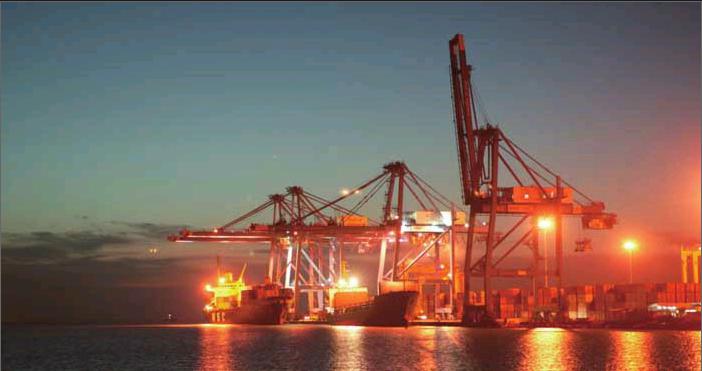China’s New Name Card
2017-08-10


Since the Belt and Road Initiative was unveiled in 2013, China Merchants Group (CMG), a leading conglomerate based in Hong Kong, has been among the nearly 50 Chinese state-owned enterprises (SOEs) investing and participating in projects along the route. By the end of 2016, the total assets of CMGs overseas branches had hit $89 billion, with revenues surpassing $5.9 billion.
CMG President Li Xiaopeng talked to Beijing Review reporter Deng Yaqing on the groups role, strategy and experience in participating in the Belt and Road blueprint. An edited version of the interview follows: Beijing Review: The Belt and Road Initiative has seen complicated changes in the international economic situation with trade protectionism making a comeback. Against this backdrop, what new opportunities do Chinese enterprises have in expanding their business overseas?
Li Xiaopeng: To begin with, the Belt and Road Initiative has opened up a huge market. Along its route there are 65 countries populated by 4.4 billion people. Their total GDP amounts to $21 trillion—roughly one third of the worlds total. However, most of them have weak economic foundations and limited government fi nancial resources. With these countries striving to accelerate industrialization, procure advanced production capacity from China and incorporate into the global value chain, Chinese enterprises will fi nd more chances to expand overseas.
Aside from that, key resources have become more accessible to Chinese players. Amidst the current sluggish global growth, chances have emerged to acquire strategic assets in developed countries.
On the other hand, in the emerging markets, due to their weak infrastructure and economic fluctuations, Chinese enterprises have the chance to acquire strategic assets to create favorable conditions for their overseas development.
Last, Chinese overseas businesses can be transformed and upgraded. President Xi Jinping proposed friendly discussions, joint construction and achievement-sharing with the countries along the Belt and Road to form a community of common interests and shared destiny and responsibility.
Given that, when tapping into the overseas market, Chinese enterprises will undergo a transformation from contracting projects and acquiring resources to laying equal stress on investment, construction and operation; from purely pursuing business opportunities to making strategic plans for overseas operation; from focusing on immediate profits to pursuing sustainable development.
Instead of merely exporting their products and services, Chinese companies will usher the countrys advantageous industries into the overseas market and try to localize their investment and operation. This will drive the export of Chinas technology, standards and currency, so that Chinese companies and their host countries can really evolve into a community of shared destiny.
What challenges do Chinese enterprises face in the process?
External economic uncertainties are mounting up, leading to increasing risks for overseas expansion. The world economy is undergoing profound adjustments, emerging countries are exposed to the aftershock of the global fi nancial crisis, and complicated geopolitical and international security situations are triggering unexpected incidents.
Besides that, the domestic economy is burdened by overcapacity, a high leverage ratio and climbing inventories. Under such circumstances, Chinese enterprises are faced with traditional risks such as economic slowdown, hindered cash flows and structural risks. At the same time, new risks are surfacing including political risks in overseas markets and exchange rate risks.
In addition to traditional trade protection measures such as anti-dumping and antisubsidy measures, the anti-globalization and rising trade protectionism trend is impeding Chinese enterprises from exploring the overseas market.
Enterprises should establish strong risk awareness and maintain confidence in the face of risks. As a whole, the Chinese economy is not likely to encounter systemic risks. Besides, strong measures should be taken to ensure our long-term interests in carrying out large investment projects overseas.
From CMGs overseas experience, I have four suggestions to overcome challenges:
First, scientific and technological innovation helps renovate business models to better meet market demand.
Second, incorporation of capacity and resources, industries and capital, people and culture should be realized between Chinese enterprises and host countries.
Third, enterprises should remain marketoriented and assess the commercial viability of investment projects from the angle of strategy, return and risk.
Fourth, a sustainable development model needs to be created by shouldering social responsibilities, such as environmental protection, charitable activities and poverty alleviation.
Chinese enterprises, SOEs in particular,should participate in international rulemaking and build international brands by virtue of their strong influence. They should use their strength to coordinate resources for other enterprises to go abroad and realize industrial agglomeration and industrial chain cooperation. They should also play a major role in facilitating peace diplomacy and safeguarding enterprises legal rights by using their skills in communicating with local governments, non-governmental organizations, communities and workers.
How has CMG adjusted its international business strategy after the Belt and Road Initiative was launched?
CMG is conducting an in-depth study of the initiative and speeding up the implementation of projects in the countries concerned. We have completed a network of ports, logistics, fi nance and industrial parks covering Southeast Asia, South Asia, Africa, Europe and Oceania, most of which are along the Belt and Road routes. We run 184 brick-and-mortar enterprises and branches in 43 countries and regions, and 49 ports in 19 countries and regions.
What are CMGs unique advantages in seeking growth along the Belt and Road? First, port operation is the key to ensuring connectivity along the Belt and Road. Some ports are in closed loops. We locate them and bring them under our belt to create conditions for the development of overseas industrial parks.
Second, given the backward infrastructure facilities and high transaction costs in countries along the Belt and Road, we hope to provide one-stop services for Chinese enterprises going out by developing industrial parks surrounding ports.
Thirdly, we promote the construction of large logistics corridors that focus on supply chain-integrated services as links of the Belt and Road. Efforts are being made to integrate the transportation resources of different countries, get rid of barriers impeding free business, material, capital and information flow and provide cross-border supply chain-integrated solutions.
We try to replicate the success of Shenzhens Shekou Industrial Zone, which facilitates the integration of industries and fi nance to generate growth force and makes full use of Hong Kongs soft power as an international fi nance and shipping center.
Besides, CMG shows a strong willingness to shoulder social responsibilities. It has funded more than 1,100 cataract patientsrehabilitation surgery in Sri Lanka, fi nancially helped large numbers of students from countries along the Belt and Road—such as Sri Lanka, Togo and South Africa—receive overseas education and offered them jobs after graduation.
Last but not least, a series of peoplebenefit projects have been carried out to narrow the psychological distance between local people and Chinese enterprises, such as funding affordable housing projects and providing free Chinese training programs in primary and middle schools.
In the countries and regions where CMG has business operations, how is the Belt and Road Initiative regarded?
More than 100 countries and international organizations have shown enthusiasm and over 40 countries and international organizations signed cooperation agreements. The Belt and Road friends circle is still expanding. Chinese enterprises have invested more than $50 billion in countries along the routes, which has created numerous jobs for the local economies.
The world as a whole has benefi ted. The Colom bo Container Port, in which we have invested, fundamentally changed the history of large container ships being unable to anchor in Sri Lanka. The maritime container transportation distance in the Indian subcontinent has been reduced by over 3,000 km, boosting the development of foreign trade in South Asia. Roughly 98 percent of the workers in the port are locals. Besides, they can choose to attend training programs in Shenzhen.
The free trade zone in Djibouti, in which the CMG invested, make the countrys GDP shoot up to $6 billion from $1.5 billion and create 100,000 jobs, which is equivalent to 20 percent of the local workforce. Since the CMG made investment in the port of Djibouti, local dockmens wages have been increasing by around 8 percent annually. A total of$2 million will be invested to build training centers in Djibouti to guarantee sustainable supply of human resources.
How do you assess the Belt and Road as being a “name card of China”?
Since the initiative was put forward, China has released an array of policies to encourage domestic enterprises to go out and Chinese enterprises have been exporting their business models, standards, capital, technology, management and innovation. In my view, all these comprise the name card of China, representing the highest level of Chinas manufacturing industry and helping Chinese enterprises have a larger say on the global stage.
The Belt and Road Initiative has created unique opportunities and conditions for Chinese enterprises to go global and let people along the route get to know China and fi nally embrace China.
